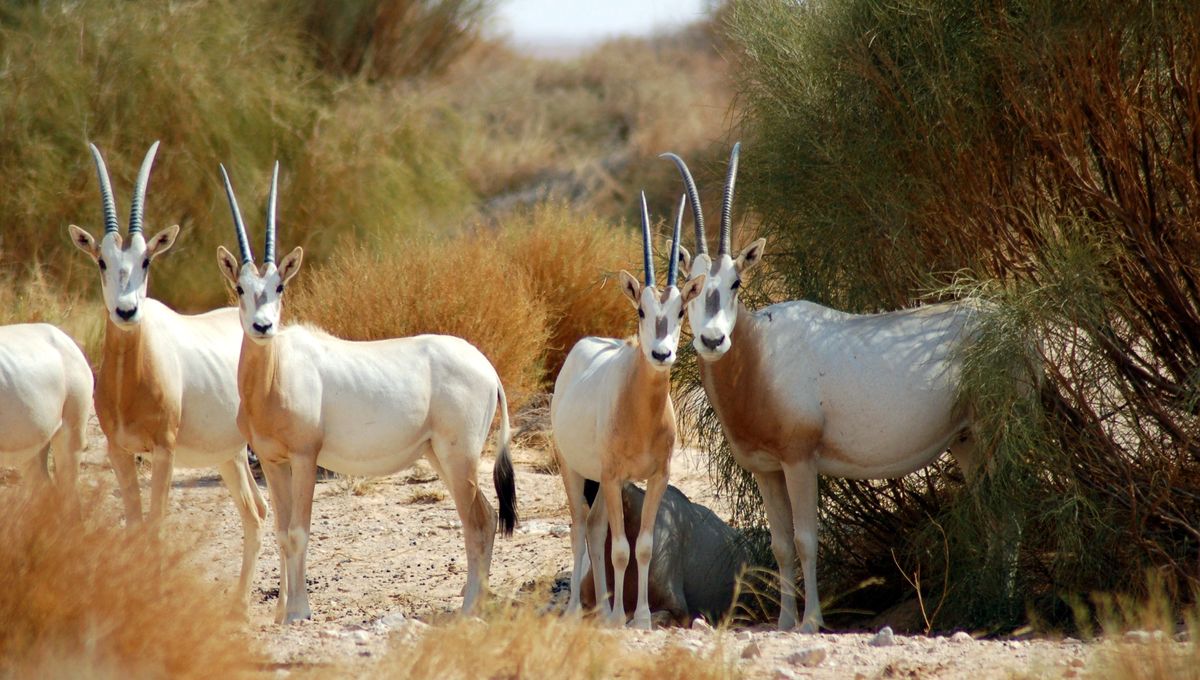
The scimitar-horned oryx (Oryx dammah), a species of antelope that was declared Extinct in the Wild by the IUCN, has been downgraded to Endangered. Conservation efforts to protect different species of animals usually take either an ex-situ approach, meaning the animal is looked after away from their natural environment, or an in-situ approach, meaning the animal is looked after in its native home or surrounding habitat. This species has changed status as a direct result of both these kinds of conservation efforts.
The scimitar-horned oryx is a large antelope species adapted for desert life. The species has elegant horns curved in the manner of a scimitar sword, giving them their name. Previously, these antelope were present across much of North Africa – however, prolonged droughts and hunting for their horns and meat in the 1980s plummeted the population numbers. In 2000, the species was declared Extinct in the Wild and has only existed in captive collections across the world.
Fortunately, in 1985, an ambitious recovery project was started with partners such as ZSL London Zoo and the Sahara Conservation Fund (SCF). The project took an in-depth approach to try to find out if a potential reintroduction program could succeed in the future. In 2009 and 2013, surveys were conducted that showed suitable areas of reintroduction: namely, Chad’s Ouadi Rimé-Ouadi Achim Game Reserve.
“The return of the scimitar horned oryx is the result of a long-term conservation effort for the species – following in-depth, careful preparation, and championed and supported by the Environment Agency of Abu Dhabi,” said Tim Wacher, ZSL’s senior conservation biologist, in a statement sent to IFLScience. “All Saharan antelope species are severely threatened, but this project is proof that with the right will and resources, we can secure a future for them all.”
In 2016, 21 scimitar-horned oryx were returned to the wild in Chad in a protected fenced area, with each animal fitted with a GPS satellite collar to allow the experts to keep track of them. The team was delighted when, around six months after the release, the first scimitar-horned oryx calf was born in the wild for more than 30 years. The following year in January 2017, 14 more oryx were released into the same area.
The goal of the project has always been to create a healthy, self-sustaining population. Since the release of the oryx back into Chad, 510 calves have been born in the wild.
The publication of a research article in the journal Science examining 95 species of plants and animals that have all been declared Extinct in the Wild but have been cared for in captivity by humans since 1950, including the oryx, coupled with the population in Chad has lead to the species being downlisted from Extinct in the Wild to Endangered.
“The change in status of scimitar-horned oryx from Extinct in the Wild to Endangered is a testament to the power of collaborative conservation action, and gives us all hope that we are able to make a real difference and restore nature,” Dr Tania Gilbert, Head of Conservation Science at Marwell Wildlife, said. “The species is still at risk from extinction (Endangered), but the conservation work in Chad, Tunisia, Morocco and Senegal greatly reduces this risk and has given the species a real chance of recovery.”
The study suggests that only one-fourth of the current Extinct in the Wild species have been part of a reestablishment program, but the success of the project shows that the reintroduction programs can work with international cooperation and conservation efforts from multiple organizations.
“Projects like the Scimitar horned oryx show that reversing the fate of these species is possible – we just need to be able to give the same resource and commitment to the other Extinct in the Wild species that survive only under human care.” said Professor John Ewen, researcher at ZSL’s Institute of Zoology and senior author of ZSL’s Extinct in the Wild study.
Source Link: After 23 Years Extinct In The Wild, Scimitar-Horned Oryx Make Triumphant Comeback